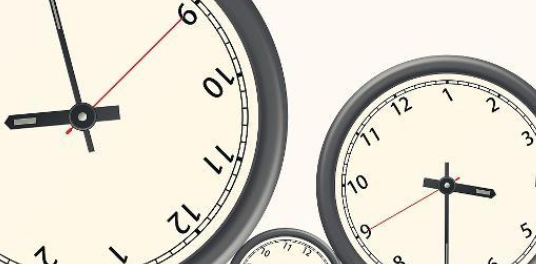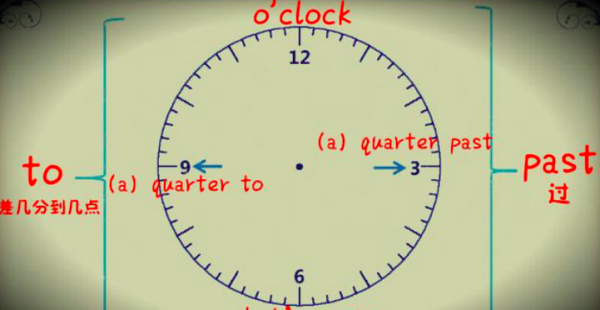本文目录
得出结论的十种英语表达
学习谈论一天中的时段:
数字可以告诉你确切的时间。但是很多人会说大概的时间而不是确切的时间。这里有几个当准确的时间点不是这么重要的时候,你可能会听到或使用到的单词。
Noon正午
Noon正午就是指12:00 p.m,也就是下午的开始。
“What time are we meeting this weekend?”
这个周末我们几点见面?
“Around noon, so we can sleep in.”
大概正午,这样我们就可以睡晚一点。
Midday中午
这有时候是跟noon正午一样的,因为noon是指一天的中间点。而Midday则是指任何在11:00 a.m.到2:00 p.m.的时间。
一般来说,这是人们开始和结束吃午餐的时间。
“It is supposed to be very hot and sunny today at midday.”
今天中午天气应该会非常热和晴朗。
Afternoon下午
因为这个词是指“after noon passes中午之后”,非常广泛的时间。可以是任何在中午12:00 p.m到日落之前(通常是大约6:00 p.m)。如果你并不是住在赤道上,那日落的时间会因季节而改变。冬天可能会是下午四点钟而夏天可能会是晚上九点钟。所以“afternoon下午”也会因为季节而变长或变短。
“I’m busy all afternoon so let’s have dinner together tonight.”
我整个下午都很忙,所以今晚一起吃晚餐吧。
Midnight半夜
”Midnight半夜“是指夜晚的中间点。但是,现在很多人都会用它来指凌晨12:00a.m,也就是隔天的开始。可以代表任何从凌晨十二点到凌晨三点的任何时间。
“People kiss on New Years Eve at midnight.”
人们在新年的半夜会接吻庆祝。
Twilight暮/黄昏
“Twilight暮光之城”对很多人而言可能只是一本畅销的小说或电影,但是暮是指当太阳几乎(非常微弱)照亮天空的时候。这可以是太阳升起之前或落下之后。记得这个时间的最好方法就是,当一天的结束和新的一天开始时,天空会变成蓝色或紫色。
“I love the way that the trees look at twilight.”
我喜欢树在黄昏时的样子。
Sunset and Sunrise日落和日出
当太阳落下(下降)或升起(上升),你可以称这个时刻为sunset日落和sunrise日出。日落是在黄昏之前,当天空开始变成粉红色和橘色但还没变黑前,日出则发生在早晨当太阳开始升起(早晨暮光发生之前),并且跟日落有一样的橘色和粉红色。
“Let’s climb the mountain before sunrise so we can watch the sun come up.”
在日出之前我们来爬山,这样我们就可以看到太阳升起的样子。
“I would rather leave in the afternoon and watch the sunset.”
我宁愿在下午离开,然后去看日落。

After Dark天黑后
天黑后的时间通常是在晚上九点到凌晨一点,或者是更晚。也可以是指城市夜生活的开始,当人们在天黑后出去喝酒或跳舞。一个很好记得的方式就是,这个时间通常是大部分人熟睡或要去睡觉的时后。
“Have you ever been to LA after dark?”
你有在天黑后去过洛杉矶吗?
“No, but I heard that it gets crazy.”
没有,但我有听说会变得非常的疯狂。
The Crack of Dawn黎明/破晓时分
“crack of dawn黎明”的实际时间是当你第一次看到天空中的亮光,但太阳却还没出现的时候。人们通常使用这个词在太阳出来之前或非常早的时候,大约早晨四点到六点之间。
“If we want to beat the traffic tomorrow we will need to wake up at the crack of dawn.”
如果我们明天想要避开交通,我们要在黎明的时候起床。
23:30,23:35,23:50,0:20,1:10
这个是有规则的,时间的表示方法有2种,一种是直接用数字,读出,例如,1:10就为
one
ten;1:50
就读做
one
fifyty;
另一种就是要用到past
(超过)
前半个小时
翻译为:几点过几分
to(到多久还差)
后半个小时
翻译为:到几点还差几分
1:10
ten
past
one
1:50
ten
to
two
1:15
a
quarter
past
one
1:45
a
quarter
to
two
2:30
half
past
two
2:00
tw丁敞弛缎佾等崇劝搐滑o
o'clock
3:20
twenty
past
three
3:40
twenty
to
four
注:a
quarter
意思是四分之一,为15分钟
half意思为一半,为30分钟
参考资料:纯手打哦

英语时间表达法
英语时间表达如下:
一.时间点的表达
1.所有的时间都可以用“小时 + 分钟”直接读:
1)6:10 six ten
2)8:30 eight thirty
3)2:40 two forty
2.如果所表述的时间在半小时之内,可以用“分钟 + past + 小时”:
1)6:10 ten past six
2)4:20 twenty past four
3)10:25 twenty-five past ten
3.如果所表述的时间在半小时之外,可以用“(相差的)分钟 + to + (下一)小时”:
1)10:35 twenty-five to eleven
2)5:50 ten to six
3)9:49 eleven to ten
4.如果所表述的时间恰好为半小时,可以用“half + past + 小时”:
1)11:30 half past eleven
2)2:30 half past two
5.如果所表述的分钟和15有关,就有三种表达法:
(15分钟又叫一刻钟:a quarter)
1)9:15 nine fifteen ; fifteen past nine ; a quarter past nine
2)3:45 three forty-five ; fifteen to four ; a quarter to four
6.整点的表达:
现在是两点整。It's two./It's two o'clock。
另外英语中的 noon 和midnight 可分别直接表示白天和夜晚的12点:
1)It's (twelve) noon。
现在是中午十二点。
2)It's (twelve) midnight。
现在是半夜零点。
7.大约时间:
1)It's almost two。
马上到两点了。
2)It's not quite two。
还不到两点。
3)It's just after two。
刚过两点。
8.若想表明是上午,可在时间后加上a.m。
如:thirteen past six a.m。(上午六点十三分)。
若想表明是下午,可在时间后加上p.m。
如:four o'clock p.m。(下午四点)。
9.句子范例:
1)It's nine forty-five。=It's a quarter to ten。
现在是九点四十五分。
2)It's two seventeen。=It's seventeen past two。
现在是两点十七分。
3)It's three。=It's three o'clock。
现在是三点。
4)It's nine thirty。=It's half past nine。
现在是九点半。
5)It's six fifteen。=It's a quarter past six。
现在是六点十五分。
6)It's three fifty。=It's ten to four。
现在是三点五十。
二.世纪、年代、年、月、日的表达
1.世纪:
1)用“定冠词+序数词+century”表示
例:在十七世纪 写作:in the 17th century,读作:in the seventeenth century
2)用“定冠词+百位进数+s”表示
例:在十七世纪 写作:in the 1600s,读作:in the sixteen hundreds
注意:这种情况下,实际表达的世纪数是阿拉伯数字本身加一。
2.年代
用“定冠词+(世纪百位进数+十位年代数)+s”表示
例:在二十世纪三十年代 写作:in the 1930s,读作:in the thirties of the twentieth century或 in the nineteen thirties
表示某年代的早期、中期和晚期,可以在定冠词后添加early, mid-和late
例如:
在二十世纪二十年代早期 in the early 1920s
在二十世纪五十年代中期 in the mid-1950s
3.年月日
1)年份
①读年份时一般分为两个单位来读,前两个数为一个,后两个数为一个:
1949 读作:nineteen forty-nine或nineteen hundred and forty-nine
② 如果是三位数,先读第一位,再把后两个数合起来读:
253 读作:two fifty-three或two hundred and fifty-three
③ 另外: 2000 读作:two thousand,1902 读作:nineteen hundred and two或 nineteen o two
④ 如果要使用year,year放在数词之前
例如:in the year two fifty-three B.C.在公元前253年
2)月份
月份是专有名词,除了少数几个月份外都有缩写形式:
January - Jan 一月
February - Feb 二月
March - Mar 三月
April - Apr 四月
August - Aug 八月
September - Sept 九月
October - Oct 十月
November - Nov 十一月
December - Dec 十二月
注意:缩写形式后面的点不能省略,因为它是表示缩写形式的符号。
3)日期:
用序数词表示
例:十月一日 写作:October 1, October 1st, 1 October, 1st October, (the) 1st of October等,其中的October都可以写成缩写形式Oct.
读作:October the first或the first of October
4)年月日
用英语表达年月日的顺序:
① 月日年
例:2002年1月17日
写作:January 17(th), 2002或January seventeenth, 2002(日和年之间需用逗号隔开)
读作:January the seventeenth, two thousand and two
②日月年
例:2002年1月17日
写作:17(th) January, 2002或the seventeenth of January, 2002(月和年之间需用逗号隔开)
读作:the seventeenth of January, two thousand and two
4. 介词的使用:
若指在哪一年或哪一月,用介词in;若具体到某一天,需用介词on。
例如:
1)She was born in 1989。
她出生于1989年。
2)She was born in August。
她出生于八月。
3)She was born in August 1989。
她出生于1989年8月。
4)She was born on 2nd August, 1989。
她出生于1989年8月2日。

扩展资料
在英语中年月日的读法和写法
一.年份
关于四位数年份的读法有下列几种情形:
1.一般情况下,将表示年份的四个数字按前后分为两组,每一组的数字都按基数词来读。
1865年读作 eighteen sixty-five
1998年读作 nineteen ninety-eight
2.如果是整百的年,后面的两个“零”读为 hundred。
1900年读作 nineteen hundred
1800年读作 eighteen hundred
3.十位数字上为“零”,该“零”读为字母 O 的发音。
1809年读作 eighteen O nine
4.关于千年的一些读法。
2000年读作 two thousand
2008年读作 two thousand and eight 或 O eight
2017年读作 two thousand and seventeen 或 two thousand seventeen
5.三位以内数字的年份,一般是按照基数词的方法来读。
531 BC 读作 five hundred (and) thirty-one BC
二.日期
日期的写法可以采用基数词和序数词两种形式。
例如: March 1也可以写成March 1st;May 29也可以写成May 29th。但是,日期的读法只能用序数词的形式。
例如:
October 31(October 31st)读作October(the)thirty-first
August 26(August 26th)读作August(the)twenty-sixth
注意:通常情况下,the 是不读出来的。
1.朗读方面
在朗读时,"月份"一般直接用英语读出;"日"则要读成"the 序数词";年份,一般分为两个单位来读,前两个数为一个单位,后两个数为一个单位。
1982 年读作 nineteen eighty-two, 1900 年读作 nineteenhundred。
如果是三位数,先读第一位,再把后两个数合起来读。
如:984 年可读为 nine eighty-four,757 年读成 sevenfifty-seven。
另外,像 2000 年一般读成 two thousand, 2001 年则读成 two thousand and one,以此类推,2004 年应读成 two thousand and four 或者 two thousand four (通常情况下“and”不读出来)。 January 12th, 1993 读成 January (the)twelfth, nineteen ninety-three。
2.书写方面
先看下面的两个例子:
1.1986 年 10 月 23 日→October 23, 1986/October 23rd, 1986
2.2002 年 1 月 17 日→January 17, 2002/January 17th, 2002
三.英美时间表达之不同
日期的表示法英国和美国稍有不同,英国通常表示为“日—月—年”,美国通常表示为“月—日—年”。如“10月10日”可表示为 October 10,1985(美)或10(th)October, 1985(英)。
注意:最好避免把整个日期都写成数字, 这在英美语中表示的含义并不相同:如“2. 7. 97”、“2-7-97”、“2/7/97”这类表达,在美国英语中表示“1997年2月7日”,而在英国英语中则表示“1997年7月2日”。
英语的时间表达法思维导图
一、时间点的表达
1、所有的时间都可以用【小时 + 分钟】直接读:
6:10 six ten
8:30 eight thirty
2:40 two forty
2、如果所表述的时间在半小时之内,可以用【分钟 + past + 小时】:
6:10 ten past six
4:20 twenty past four
10:25 twenty-five past ten

3、如果所表述的时间在半小时之外,可以用【(相差的)分钟 + to + (下一)小时】:
10:35 twenty-five to eleven
5:50 ten to six
9:49 eleven to ten
4、如果所表述的时间恰好为半小时,可以用【half + past + 小时】:
11:30 half past eleven
2:30 half past two
5、如果所表述的分钟和15有关,就有三种表达法:
(15分钟又叫一刻钟:a quarter)
9:15
nine fifteen ; fifteen past nine ; a quarter past nine
3:45
three forty-five ; fifteen to four ; a quarter to four
6、整点的表达:
It's two./It's two o'clock.
现在是两点整。
(另外英语中的 noon 和 midnight 可分别直接表示白天和夜晚的12点)
现在是中午十二点。
It's (twelve) noon.
现在是半夜零点。
It's (twelve) midnight.
二、世纪、年代、年、月、日的表达
1、世纪:
①用“定冠词+序数词+century”表示。
例:在十七世纪 写作:in the 17th century,读作:in the seventeenth century.
②用“定冠词+百位进数+s”表示。
例:在十七世纪 写作:in the 1600s,读作:in the sixteen hundreds.
注意:这种情况下,实际表达的世纪数是阿拉伯数字本身加一。
2、年代
用“定冠词+(世纪百位进数+十位年代数)+s”表示。
例:在二十世纪三十年代 写作:in the 1930s,读作:in the thirties of the twentieth century或 in the nineteen thirties.
三、 年月日
1)年份
① 读年份时一般分为两个单位来读,前两个数为一个,后两个数为一个:
1949 读作:nineteen forty-nine或nineteen hundred and forty-nine
② 如果是三位数,先读第一位,再把后两个数合起来读:
253 读作:two fifty-three或two hundred and fifty-three
③ 另外: 2000 读作:two thousand,1902 读作:nineteen hundred and two或 nineteen o two
④ 如果要使用year,year放在数词之前。
例如:in the year two fifty-three B.C. 在公元前253年
以上就是关于20个英语时间 ,得出结论的十种英语表达的全部内容,以及20个英语时间 的相关内容,希望能够帮到您。

